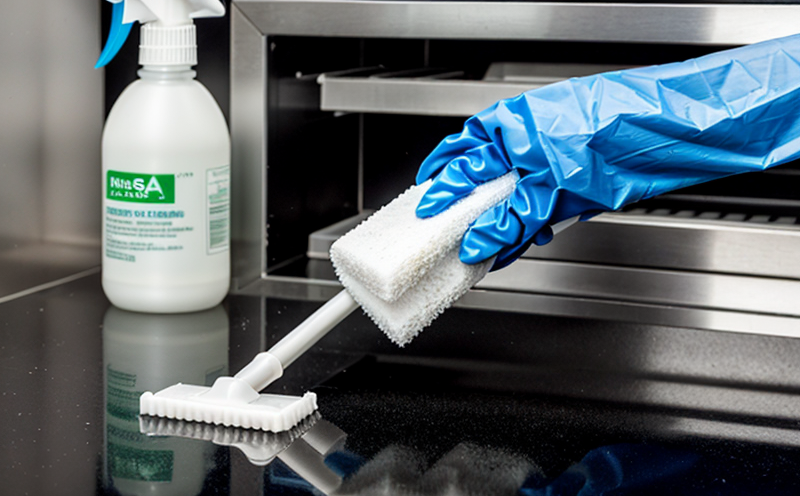BS EN ISO 16869 Hygienic Property Testing of Plastics
The BS EN ISO 16869 standard provides a framework for ensuring that plastics used in contact with food, beverages, pharmaceuticals, and other hygienic products meet stringent hygiene requirements. This testing ensures the safety and integrity of materials that come into direct or indirect contact with consumers.
Hygiene properties of plastic materials are critical to prevent contamination by microorganisms, chemicals, or any other harmful substances from migrating onto the product in contact. The standard covers a range of tests designed to evaluate the hygienic performance of plastics under specific conditions. These tests include microbial barrier evaluation (MBE), migration testing, and permeability assessment.
Microbial Barrier Evaluation is one of the key aspects tested under BS EN ISO 16869. It aims to determine whether a plastic material can effectively prevent microorganisms from passing through it. This test involves exposing the sample to various bacterial strains such as Escherichia coli and Salmonella spp., followed by incubation periods during which any growth would indicate that the barrier is not effective.
Migration Testing assesses how much of certain chemicals or compounds can migrate from the plastic into food, beverages, or other products. This is crucial because some plastic additives may leach out when exposed to specific conditions like heat or prolonged contact with liquids. The standard specifies precise methods for determining migration limits based on potential health risks.
Permeability Assessment evaluates how easily gases can pass through the material, which could affect its shelf life and overall performance. Gases such as oxygen and carbon dioxide are commonly evaluated in this context. Understanding permeability helps manufacturers design packaging that will protect their products effectively over time.
The testing process typically begins with selecting appropriate specimens according to the type of plastic being tested and intended use. Specimens must be prepared carefully following prescribed procedures outlined in the standard, ensuring they accurately represent real-world conditions. Once prepared, these samples undergo rigorous testing using specialized equipment designed for hygienic property evaluation.
After completing all required tests, laboratories produce detailed reports summarizing results across different parameters measured during assessment. These documents serve as evidence supporting compliance with BS EN ISO 16869 and can be used by manufacturers to demonstrate adherence to regulatory requirements or internal quality standards.
Compliance with this standard is essential for businesses operating within the food, beverage, pharmaceuticals industries, among others. By adhering strictly to its provisions, companies ensure their products remain safe throughout manufacturing processes all the way up until they reach end consumers. Additionally, meeting these stringent hygiene criteria enhances brand reputation and builds consumer trust.
Our laboratory offers comprehensive BS EN ISO 16869 hygienic property testing services tailored specifically for polymer and plastic materials used in contact with food, beverages, pharmaceuticals, medical devices, and other sensitive applications. Our experienced technicians use state-of-the-art equipment and follow strict protocols to deliver accurate and reliable test results.
When considering your next project involving high-quality hygienic plastics, consult our experts today to ensure successful outcomes aligned with international standards like BS EN ISO 16869.
Applied Standards
- BS EN ISO 16869:2018: Hygienic properties of materials and articles intended to come into direct or indirect contact with food, beverages, pharmaceuticals, medical devices, and other sensitive applications.
- ASTM F713-14: Standard test methods for determining the microbiological barrier effectiveness of films and sheeting used in the packaging of foods, drugs, cosmetics, etc.
- EN ISO 9001:2015: Quality management systems – requirements.
The BS EN ISO 16869 standard incorporates elements from multiple international standards to provide a robust framework for evaluating the hygienic properties of materials used in contact with various products. By adhering strictly to these guidelines, manufacturers can ensure their products meet stringent hygiene and safety criteria.
Quality and Reliability Assurance
To maintain high standards of quality and reliability in our BS EN ISO 16869 hygienic property testing services, we employ a multi-step approach:
- Initial Consultation: We begin by discussing your specific requirements with you to tailor the testing process accordingly.
- Sample Preparation: Our skilled technicians prepare specimens following precise protocols outlined in the standard. This step ensures that all samples are representative of real-world conditions.
- Testing Process: Using advanced equipment, our lab conducts thorough testing across multiple parameters including microbial barrier evaluation, migration testing, and permeability assessment.
- Data Analysis: After completing all tests, our data analysts interpret results meticulously to ensure accuracy and reliability.
- Reporting: Detailed reports are generated summarizing findings from each test. These documents provide comprehensive evidence supporting compliance with BS EN ISO 16869 standards.
- Follow-Up Recommendations: Based on our analysis, we offer recommendations to improve the hygienic performance of your materials or processes if necessary.
This rigorous quality assurance process ensures that every aspect of the testing is conducted accurately and consistently. Our goal is to deliver reliable data that supports informed decision-making throughout the product development lifecycle.
Use Cases and Application Examples
The BS EN ISO 16869 standard applies broadly across various sectors where hygiene is paramount, including food packaging, pharmaceutical manufacturing, medical device production, and more. Here are some specific use cases:
- Packaging for Ready-to-Eat Meals: Ensuring that containers used to store ready-to-eat meals maintain their integrity during transportation and storage.
- Pharmaceutical Bottles: Verifying that medication bottles do not allow contaminants to enter, thus preserving the efficacy of medications.
- Medical Device Packaging: Confirming that packaging materials used for sterile medical devices remain free from pathogens post-sterilization.
- Beverage Containers: Guaranteeing that plastic bottles and cans for beverages maintain their chemical stability, preventing any harmful substances from leaching into the drink.
- Food Contact Surfaces: Assessing surfaces in food processing facilities to ensure they do not harbor microorganisms or transfer undesirable compounds to food products.
- Baby Bottle Accessories: Checking that accessories like nipples and lids for baby bottles meet strict hygiene standards to protect infants' health.
These examples illustrate just a few ways in which BS EN ISO 16869 plays a crucial role in safeguarding public health by ensuring the safety of hygienic products.





